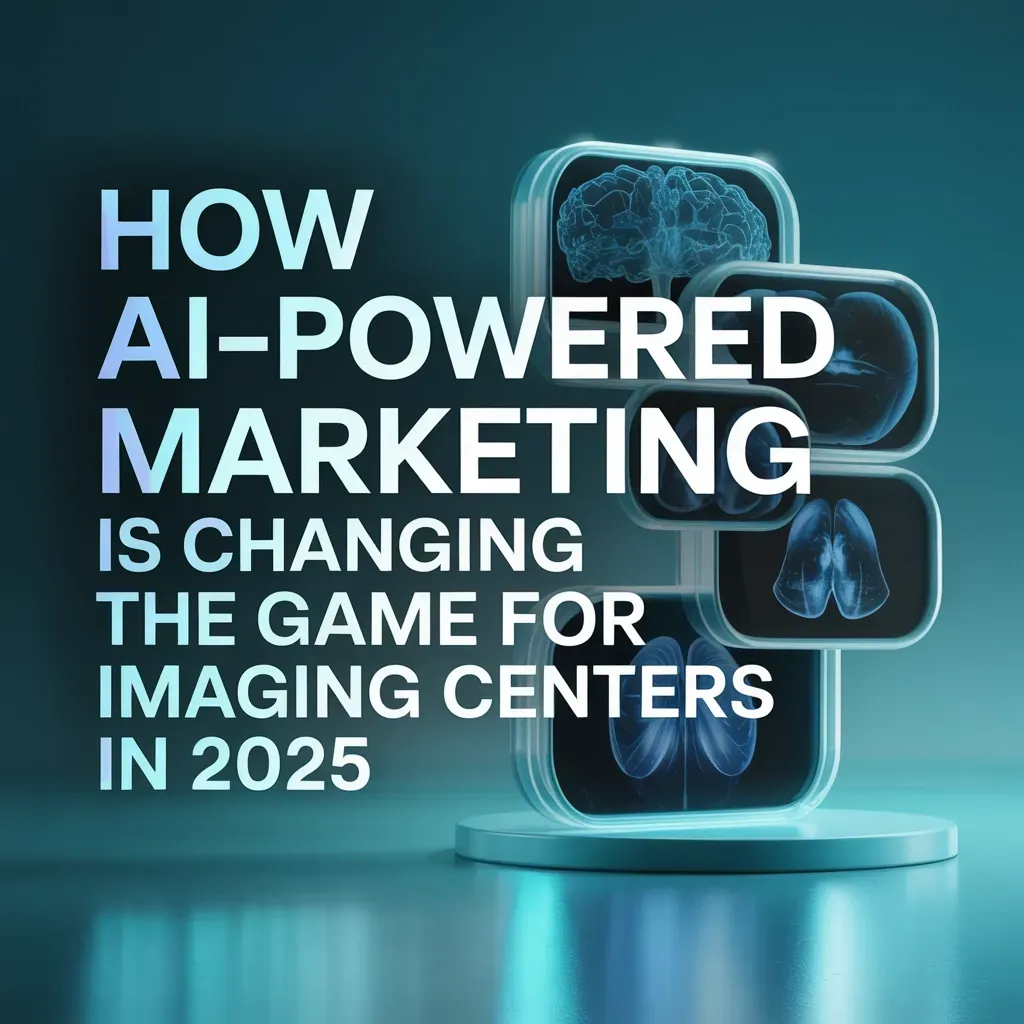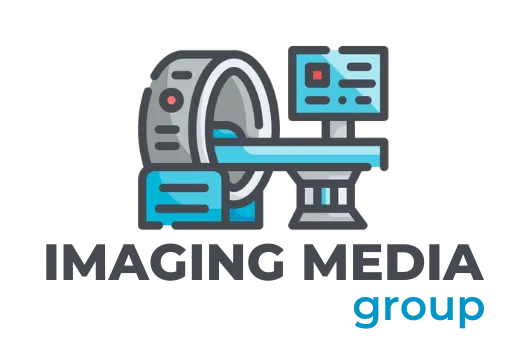
How AI-Powered Marketing Is Changing the Game for Imaging Centers in 2025

In today's hyper-competitive healthcare landscape, imaging centers face unprecedented challenges in patient acquisition and retention. The good news? Artificial intelligence has emerged as a powerful ally, fundamentally transforming how diagnostic imaging facilities approach their marketing strategies. As we navigate through 2025, the integration of AI into marketing operations isn't just a competitive advantage; it's becoming essential for survival and growth.
The Shifting Landscape of Imaging Center Marketing
Traditional marketing approaches for imaging centers typically relied on physician referrals, community outreach, and basic advertising. While these methods remain important, they're no longer sufficient in a marketplace where patients increasingly research and choose their own healthcare providers.
"The diagnostic imaging market has evolved from physician-controlled referrals to patient-driven selection processes," says Dr. Emily Richardson, Chief Innovation Officer at Northeast Radiology Network. "Centers that aren't adapting their marketing approaches to this new reality are seeing significant declines in patient volume."
This evolution requires imaging centers to develop sophisticated marketing strategies that address the entire patient journey, from awareness to post-procedure engagement. AI-powered tools have become instrumental in executing these strategies effectively and efficiently.

How AI Is Revolutionizing Imaging Center Marketing
1. Hyper-Personalized Patient Outreach
Gone are the days of generic marketing messages sent to broad demographics. AI algorithms now analyze vast datasets including patient demographics, medical history, insurance coverage, and previous interactions to create highly targeted outreach campaigns.
For example, AI systems can identify individuals due for specific screenings based on age, risk factors, and medical history, then automatically generate personalized communications emphasizing the specific benefits most relevant to their situation. These communications can be delivered through the channel most likely to generate a response from each individual patient, whether that's email, text, social media, or traditional mail.
A major California imaging network implemented this approach in late 2024 and reported a 37% increase in screening appointment bookings within three months, demonstrating the power of AI-driven personalization.
2. Predictive Analytics for Strategic Decision Making
AI-powered predictive analytics has transformed how imaging centers forecast demand, allocate resources, and plan marketing initiatives. These sophisticated systems analyze historical data alongside external factors like seasonal trends, local healthcare events, and even weather patterns to predict future patient volumes with remarkable accuracy.
"The predictive capabilities we now have through AI have completely changed our marketing budget allocation," notes Marketing Director Sarah Chen of Midwest Diagnostic Imaging. "We can confidently shift spending toward specific modalities or geographic areas based on anticipated demand, rather than relying on gut feeling or historical performance alone."
These systems also help identify potential market opportunities by detecting patterns in referral sources, patient demographics, and service utilization that human analysts might miss. For imaging centers with multiple locations, AI can recommend optimal service distribution and marketing focus for each facility based on neighborhood demographics and competitor presence.
3. Conversational AI and Virtual Assistants
Perhaps the most visible application of AI in imaging center marketing is the proliferation of sophisticated conversational AI tools that engage with patients through websites, messaging platforms, and even voice channels.
Modern AI assistants go far beyond basic chatbots. They can answer detailed questions about preparation instructions, insurance coverage, and procedure expectations. They can facilitate appointment scheduling, pre-registration, and insurance verification, all while maintaining a conversational tone that puts patients at ease.

The benefits extend beyond convenience. By analyzing thousands of patient interactions, these systems identify common concerns and questions, helping imaging centers refine their marketing messaging to address these issues proactively. They also capture valuable data about what prospective patients are seeking, informing service development and marketing strategy.
One particularly effective application is in reducing no-shows. AI systems track patterns in missed appointments and automatically adjust reminder frequency and messaging for patients with higher risk profiles. Some centers report no-show reductions of up to 40% after implementing these targeted reminder systems.
Learn more about automated patient engagement strategies in our comprehensive guide on automated patient engagement in radiology practices.
4. AI-Optimized Digital Advertising
Digital advertising has been transformed by AI algorithms that continuously optimize campaign performance across multiple platforms. For imaging centers, this means more efficient use of marketing budgets and higher returns on ad spend.
Today's AI marketing platforms automatically:
Test multiple ad variations to identify top performers
Adjust bidding strategies in real-time based on conversion likelihood
Target ads to the most responsive audiences
Shift budget allocation across platforms for maximum results
Generate performance reports with actionable insights
"We've seen our cost per acquisition drop by nearly 30% since implementing AI-driven campaign management," reports Tom Williams, Digital Marketing Manager at Atlantic Coast Imaging. "The system continuously learns what works and makes adjustments far more quickly and precisely than our team could manually."
For imaging centers wondering if Google Ads should be part of their strategy, check out our article on why diagnostic centers should use Google Adwords.
5. Reputation Management and Patient Feedback Analysis
Online reputation has become a critical factor in patient decision-making. AI-powered sentiment analysis tools now scan reviews across dozens of platforms to identify trends in patient feedback and flag issues requiring immediate attention.
These systems categorize feedback by topic (wait times, staff friendliness, billing clarity, etc.) and sentiment, allowing imaging centers to identify specific areas for operational improvement while also highlighting strengths that can be emphasized in marketing materials.
Some advanced systems even correlate review sentiment with specific operational factors like staffing levels, equipment downtime, or appointment scheduling practices, providing actionable insights for improving both patient experience and marketing effectiveness.
For more on this critical topic, read our article on why imaging centers should maximize positive Google reviews.
6. Content Marketing Automation
Content remains king in healthcare marketing, but creating consistent, relevant content is resource-intensive. AI content tools now assist imaging centers in developing educational materials, blog posts, social media content, and even video scripts that resonate with target audiences.
These systems analyze high-performing healthcare content across the web, identify trending topics relevant to imaging services, and suggest content ideas most likely to engage specific audience segments. Some platforms can even generate draft content that marketers can refine and personalize, dramatically increasing content production capacity.
"Our monthly content output has tripled since adopting AI content assistance tools," says Maria Gonzalez, Content Director at Southwest Medical Imaging. "More importantly, our engagement metrics have improved because we're creating more relevant content informed by actual patient interests."
Discover more about effective content marketing strategies in our guide on using content marketing to educate patients about imaging services.

Implementation Challenges and Solutions
While the benefits of AI-powered marketing are substantial, imaging centers face several challenges when implementing these technologies:
Data Privacy and Compliance
Healthcare marketing operates within strict regulatory frameworks like HIPAA. AI systems require careful implementation to ensure patient data is protected while still leveraging insights for marketing purposes.
Solution: Work with marketing technology providers experienced in healthcare compliance. Implement robust data governance frameworks that clearly define what data can be used for marketing purposes and ensure all systems meet or exceed regulatory requirements.
Integration with Existing Systems
Many imaging centers operate with a mix of legacy systems and newer platforms, making data integration challenging.
Solution: Prioritize marketing AI solutions with strong API capabilities and experience integrating with common healthcare systems. Consider implementing a customer data platform (CDP) specifically designed for healthcare to create a unified patient data repository that can feed AI marketing tools while maintaining compliance.
Cost Considerations
Advanced AI marketing technologies require significant investment, which can be challenging for independent imaging centers.
Solution: Start with high-impact, targeted implementations rather than complete system overhauls. Many AI marketing tools now offer scalable pricing models that allow centers to begin with basic functionality and expand as ROI is demonstrated.
Staff Adoption and Training
Marketing AI tools are only effective when properly utilized by marketing teams.
Solution: Invest in comprehensive training programs and consider partnering with specialized healthcare marketing agencies like Imaging Media Group that can provide both technology implementation and ongoing operational support.
Measuring Success: Key Performance Indicators
Implementing AI marketing technologies without proper measurement frameworks is a recipe for disappointment. Successful imaging centers track several key metrics to evaluate their AI marketing investments:
Customer Acquisition Cost (CAC): The total cost to acquire a new patient, including all marketing expenses
Patient Lifetime Value (LTV): The projected revenue a patient will generate over their relationship with your center
Appointment Conversion Rate: The percentage of marketing-generated leads that result in scheduled appointments
No-Show Rate: The percentage of scheduled patients who fail to appear for appointments
Return on Marketing Investment (ROMI): The revenue generated per dollar spent on marketing activities
Online Reputation Metrics: Average review ratings and sentiment analysis trends
Service Line Growth: Increases in specific procedure volumes targeted by marketing campaigns
The most sophisticated centers use AI-powered analytics dashboards that automatically collect and visualize these metrics, providing real-time insights into marketing performance.
The Future of AI Marketing for Imaging Centers
As we look beyond 2025, several emerging trends will likely shape the future of AI-powered marketing for imaging centers:
Voice-First Engagement: As voice assistant usage continues to grow, imaging centers will need to optimize their digital presence for voice search and develop voice-based scheduling and information systems.
Predictive Health Marketing: AI systems will increasingly identify patients who would benefit from specific imaging procedures before they experience symptoms, enabling truly preventative care marketing.
AR/VR Facility Tours: Virtual facility tours using augmented and virtual reality will become standard components of imaging center marketing, reducing patient anxiety and increasing conversion rates.
Hyper-Local Marketing Automation: AI systems will enable highly targeted neighborhood-level marketing campaigns based on demographic data, local health trends, and competitor analysis.
Integrated Patient Journey Orchestration: Marketing, scheduling, clinical, and follow-up systems will work together seamlessly to create cohesive patient experiences orchestrated by AI.
To learn more about video marketing opportunities, read our article on why use video marketing for showcasing imaging diagnostic technology.
Key Takeaways and Next Steps
AI-powered marketing isn't just changing how imaging centers promote their services; it's transforming the entire patient acquisition and retention process. Centers that embrace these technologies gain significant competitive advantages:
More efficient marketing budget allocation
Higher patient acquisition and retention rates
Improved patient experiences from first touch to post-procedure follow-up
Better reputation management and community presence
Data-driven decision making for both marketing and operations
For imaging centers looking to implement or enhance AI marketing capabilities, consider these steps:
Audit Your Current Marketing Technology Stack: Identify gaps and opportunities for AI enhancement.
Prioritize High-Impact Use Cases: Focus first on applications with clear ROI potential, such as appointment scheduling optimization or personalized patient outreach.
Develop a Robust Measurement Framework: Ensure you can accurately track the impact of AI marketing initiatives.
Invest in Staff Training: Equip your team with the skills to effectively leverage new AI marketing tools.
Partner with Healthcare Marketing Experts: Work with specialists who understand both imaging center operations and advanced marketing technologies.
Ready to transform your imaging center's marketing approach with AI-powered solutions? Contact Imaging Media Group for a comprehensive marketing assessment and customized AI implementation strategy. Our team of healthcare marketing specialists combines deep industry knowledge with cutting-edge technical expertise to help imaging centers thrive in today's competitive environment.
For more insights on optimizing your diagnostic imaging marketing strategy, explore our comprehensive guide for 2023 (with principles that remain relevant in 2025).
Don't just adapt to the changing marketing landscape; lead the transformation with AI-powered strategies that deliver measurable results for your imaging center.
Still have questions? Want to see how we can help you achieve success? Reach out.
Use the form to the right to reach out to us and speak with a representative, and learn how you can grow your Imaging Center.
Let's Chat
Contact Us
© 2025 Imaging Media Group - All Rights Reserved
Imaging Media Group and SalesPilot CRM are divisions of Mixed Media Ventures

